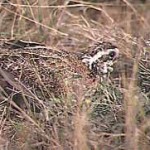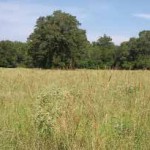K. Brian Hays, Matthew Wagner, Fred Smeins and R. Neal Wilkins
L-5456
3-05

(Courtesy of the Samuel Roberts Noble Foundation, Ardmore, Oklahoma.)
The native grasslands of Texas have been steadily disappearing since the arrival of the first settlers. With urban development and the conversion of land to row crops and pastures of non-native grasses, only about 96 million of the original 148 million acres of native grasslands remain. Much of the remaining grassland area has been degraded by overgrazing and the encroachment of brush.

Figure 1. Much of the native grassland in Texas has been converted to improved pastures (left) or cropland (right).
The conversion of native grasslands to non-native pasture grasses is one of the most notable changes in land use in Texas over the last decade (Fig. 1). There are now more than 10 million acres of nonnative pastureland in Texas, with much of it planted to coastal bermudagrass for hay production and cattle grazing. Bermudagrass and other
non-native grasses are normally managed as monotypic (single species) stands of grass, so the plant diversity of the original ecosystem is lost.
Non-Native Grasses and Wildlife
The conversion of native grasslands to bermudagrass pasture is detrimental to most native wildlife species. Bermudagrass is a dense, matting grass that provides little cover or nesting habitat for bobwhite quail, turkeys and songbirds. Its growth structure eliminates bare ground, which these birds need for feeding and moving easily through the landscape. Bermudagrass crowds out the native forbs (broadleaf species) and grasses that provide food for birds and other native wildlife.
Species such as bobwhite quail, bobolink, dickcissel, eastern meadowlark, grasshopper sparrow and Attwater’s prairie chicken are all dependent upon habitats associated with healthy native grasslands, and all of these species have been declining over the last 2 decades.
Reasons for Restoring Native Grasslands
Many cattle producers and other rural landowners are looking for ways to reduce the amount of money and labor invested in their operations. It can be costly to grow bermudagrass because it requires regular fertilization to produce high quality forage and hay. Many warm-season native grasses and forbs produce enough forage, with adequate protein, to meet the needs of livestock without expensive fertilization. Little bluestem, Indiangrass, switchgrass and others are considered excellent forage for livestock and hay production. The native bunchgrasses make ideal habitat for wildlife that depend on these plants for food, cover and nesting. The bare ground between bunchgrasses makes excellent travel and feeding areas for grassland birds and also allows a variety of native forbs to germinate and grow.
Many landowners are also interested in enhancing wildlife habitat on their properties. The Texas property tax code now allows landowners to retain their agricultural tax valuation if they manage and/or restore their land for wildlife habitat, and this includes the restoration of native grasses. This tax incentive may extend to owners of smaller tracts that are often created when large ranches
are sold and subdivided, but there are different acreage minimums in different regions of the state. Restoring native grasslands is an important way to enhance wildlife habitat and meet one requirement for qualifying for wildlife management tax valuation.
Converting Pastures to Native Grasslands
Before native grasses are planted, bermudagrass must be controlled. Treating it with herbicide is a primary means to reduce or remove it. The bermudagrass should be treated when it is actively growing. Bermudagrass usually starts to grow when the soil temperature reaches 65 degrees F, which is earlier on sandy soils than on clay soils. Therefore, bermudagrass on clay soils should be treated later in the year when the weather is warm, and may need more than one herbicide application. A stand also may need more than one application of herbicide if it is especially vigorous. So soil type and the vigor of the bermudagrass will affect the timing of both herbicide application and seed planting.
- Suggested steps in restoring native grasses are as follows:
- Determine the location and acreage of the pasture to be converted to native vegetation.
- Burn, mow or heavily graze the site during late winter to prepare it for herbicide application. Remove as much plant litter as possible.
-
Purchase seed and herbicide and arrange for services such as tractor work and herbicide application.
- Once the bermudagrass is actively growing and at least 6 inches high, apply glyphosate herbicide (41% active ingredient) at a rate of 4 quarts per acre on sandy soils and 6 quarts per acre on clay soils. The best time for herbicide application in South Central Texas (based on research) is after May 15. The date will vary in other parts of the state. Midsummer, when the weather is hot and humid, may be the best time. If more than one application is needed, apply 2 quarts per acre in June, 2 quarts in July and 2 quarts in August.
- If one application is made, use a no-till drill to plant native seed into dead sod about 2 weeks after spraying. The native seed mix should contain several bunchgrass and forb species that occur in the area (ask your county Extension agent, Texas Parks and Wildlife Department biologist, or the local Natural Resources Conservation Service staff about a recommended mix for your area). The recommended seeding rate is 6 to 7 pounds of pure live seed (PLS) per acre. Another method is to disk the sprayed area and broadcast seed. If seed is broadcast, the amount of seed should be doubled to compensate for weed competition. If more than one herbicide application is needed throughout the summer, delay seeding until late winter or early spring and plant with a no-till drill. Seed must have adequate soil moisture to germinate.
- Exclude the planted area from grazing for at least two nondrought growing seasons.
- Once the native grasses and forbs are established, manage the area with prescribed burning every few years or with rotational grazing. This will prevent thatch formation, stimulate growth and maintain vegetation diversity.
Expected Results
Research was done on sandy, sandy loam and clay soils in Washington, Falls and Grimes Counties in South Central Texas. Three different rates of glyphosate herbicide were tested–6 quarts, 5 quarts and 4 quarts per acre. Two years after application, the three rates produced an average of 86 percent bermudagrass control on sandy soil, 90 percent on sandy loam soil, and 52 percent on clay soil. Better control might be observed on clay soils if the herbicide is applied later in the spring or more than one application is made.
Native species can be slow to establish from seeding. However, controlling the bermudagrass with herbicide will reduce the competition for sunlight and nutrients and help the native species become established.
Other native grasses and forbs are likely to emerge along with the species that are planted. On test sites, these other species included wooly croton, ragweed and broad-leaf signalgrass. The test sites have gone from one species (bermudagrass) to an average of nine grass species and eleven forb species per site. This diverse plant community can now provide wildlife with food and cover that was lacking before.
Figures 2, 3 and 4 show the diversity of plants at test sites two growing seasons after seeding. All sites were treated with 6 quarts per acre of glyphosate in the spring and planted with a no-till drill in the spring.
Because native grass and forb seeds need moisture to germinate, there is some risk involved with seeding. The landowner must adjust the restoration plan according to the amount of rainfall received. For example, if the spring is drier than normal, it might be best to wait until summer to treat the bermudagrass and then plant in the fall or the following spring. For more information see publications E-53 and E-117 (both from Texas Cooperative Extension and available at http://tcebookstore.org)
Landowner Resources
The cost of converting bermudagrass pastures to native grasslands is an estimated $100 to $200 per acre or more, depending on the cost of herbicide and seed. One way to do it less expensively is to stop adding fertilizer and soil amendments to bermudagrass pastures while grazing them heavily during the spring and early summer. Eventually this will reduce bermudagrass vigor and cover and allow native species to become established; it is a much lengthier process, however.
Technical and/or cost-share assistance are available to landowners through the following programs.
PUB–Pastures for Upland Birds
Administered by the Texas Parks and Wildlife Department 1-800-792-1112
http://www.tpwd.state.tx.us/ conserve/wildlife_management/ post_oak/upland_game/pub
- Provides herbicide and no-till drilling for converting bermudagrass pastures to native grasslands
LIP–Landowner Incentive Program
Administered by the Texas Parks and Wildlife Department 1-800-792-1112
http://www.tpwd.state.tx.us/ conserve/lip/
- Helps landowners protect and manage rare species (can include native grasslands)
Farm Bill
Administered by the United States Department of Agriculture, Natural Resources Conservation Service (Texas NRCS, 254-742-9800 http://www.tx.nrcs.usda.gov/ programs/)
- Several programs offer incentives for conserving natural resources
Playa Lakes Joint Venture
- Provides technical, financial and educational assistance for conservation work on private land in the Panhandle
Ducks Unlimited
Prairie Wetland Project 832-595-0663 http://www.ducks.org
- Provides technical, financial and educational assistance for conservation work on private land
Partners for Fish and Wildlife Program
Administered by United States Fish and Wildlife Service 817-277-1100 http://partners.fws.gov
- Helps landowners protect, manage and restore natural resources.
Landowners may also find helpful information at the following Web sites:
Additional Reading
B-182, “Know Your Grasses” (Texas Cooperative Extension).
B-6134, “Texas Rural Lands: Trends and Conservation Implications for the 21st Century” (Texas Cooperative Extension).
E-53, “Seeding Rangeland” (Texas Cooperative Extension).
E-117, “Rangeland Risk Management for Texans: Seeding Rangeland” (Texas Cooperative Extension).
Conner, R., A. Seidl, L. Van Tassel and N. Wilkins. 2001. United States Grasslands and Related Resources: An Economic and Biological Trends Assessment (http://landinfo.tamu.edu).
Demaso, S. J., W. P. Kuvlesky, Jr., F. Hernandez and M. E. Berger, editors. 2002. Quail V: Proceedings of the Fifth National Quail Symposium. Texas Parks and Wildlife Department. Austin, Texas.
 Guthery, F. S. 1986. Beef, Brush and Bobwhites. Caesar Kleberg Wildlife Research Institute Press, Kingsville, Texas.
Guthery, F. S. 1986. Beef, Brush and Bobwhites. Caesar Kleberg Wildlife Research Institute Press, Kingsville, Texas.
Leithead, H. L., L. L. Yarlett ad T. N. Shiflet. 1971. 100 Native Forage Grasses in 11 Southern States. Agricultural Handbook No. 389. Soil Conservation Service, USDA.
Porter, W. F. 1992. “Habitat requirements,” pp. 202-213 in J. G. Dickson, ed., The Wild Turkey: Biology and Management. Stakpole Books, Harrisburg, Pennsylvania.
Texas A&M AgriLife Extension Service
AgriLifeExtension.tamu.edu
More Extension publications can be found at AgriLifeBookstore.org
Educational programs of the Texas A&M AgriLife Extension Service are open to all people without regard to race, color, sex, disability, religion, age, or national origin.
The Texas A&M University System, U.S. Department of Agriculture, and the County Commissioners Courts of Texas Cooperating. Produced by Texas A&M AgriLife Communications



